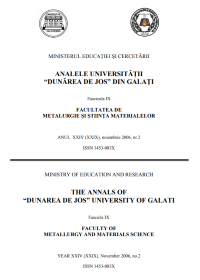Possibilities to Evaluate the Value of the Marangoni Effect and of the Marangoni Number in Refining Steel-Slag/Inclusion Systems
Abstract
Starting from the impressive progress in studying the instabilities induced by capillary effects in systems of two immiscible fluids in chemistry, an analysis of factors in solutal Marangoni effect and Marangoni number is performed, regarding the liquid steel surface as a part of the interface in systems steel-slag/inclusion. Low alloyed, microalloyed and carbon steel are taken into consideration because of their closed behavior to liquid iron solutions. Computing relations of surface tension of solutions Fe-O-S and interface tension between the same solutions and Al2O3 inclusion, also of the diffusion coefficients of the solutes are proposed to be used in computind the contribution of solutal effects in Marangoni effect and Marangoni number.
Downloads
References
[2]. Nepomnyashchy, A.A, Velarde, M.G., Colinet,P. ”Interfacial Phenomena and Convection “ Chapman and Hall/CRC, Boca Raton, 2002.
[3]. Sherwood, T.S., Wei, J.C., “Interfacial phenomena in liquid extraction”Ind.Eng. Chem. 49(1957), 1030.
[4]. Dupeyrat, M., Nakache, E. ‘‘Direct conversion of chemical energy into mechanical energy at an oil–water interface’’ Bioelectrochem.Bioenerg. 5 (1978), 134.
[5]. Nakache, E., Dupeyrat, M., Vignes-Adler, M. “Experimental and theoretical study of an interfacial instability at some oil–water interfaces involving a surface-active agent” J. Colloid Interface Sci. 94(1983), 187.
[6]. Nakache, E., Dupeyrat, M. “The contribution of chemistry to new Marangoni mass transfer instabilities at the oil/water interface”Faraday Discuss.Chem.Soc.,77(1984), 189.
[7]. Science and Practice of Liquid–Liquid Extraction, edited J. D. Thornton, Clarendon, Oxford, 1992.
[8]. Avnir, D., Kagan, L.M. “The evolution of chemical patterns in reactive liquids driven by hydrodynamic instabilities.”Chaos, 5 (1995), 589.
[9]. Kai,S., Muller,S.C., Mori, T., Miki,M. “Chemically driven nonlinear waves and oscillations at an oil–water interface.” Physica D, 50(1991), 412.
[10]. Eckert, K., Grahn, A. “Plume and finger regimes driven by a exothermic interfacial reaction.” Phys. Rev. Lett. 82(1999), 4436.
[11]. Eckert, K., Acker, M., Shi, Y.‘‘Chemical pattern formation driven by a neutralization reaction. I. Mechanism and basic features,’’ Phys. Fluids 16(2004), 385.
[12]. Ermakov, S.A., Ermakov, A.A., Chupakhin, O.N., Vaissov, D.V. “Mass transfer with chemical reaction in conditions of spontaneous interfacial convection in processes of liquid extraction,’’ Chem. Eng. J. 84(2001), 321.
[13]. Ruckenstein, E., Berbente, C., “The occurrence of interfacial turbulence in the case of diffusion accompanied by chemical reaction,’’ Chem. Eng. Sci. 19(1964), 329.
[14] Sternling, C.V., Scriven, L.E., “Interfacial turbulence: Hydrodynamic instability and the Marangoni effect.“ AIChE J. 5(1959), 514.
[15] Chung, Y., Cramb, A.W. “Dynamic and Equilibrium Interfacial Phenomena in Liquid Steel-Slag Systems” Metallurgical and Materials Transactions,vol.31B(2000), 957-971.
[16]. Nita, P.S. “Influence of Marangoni effect on steel refining processes, in ladle-type reactor treatment” Metalurgia 54(2002), 17-20.
[17]. Nita, P.S., Goarza, A.C., “An improved model of the surface energy for iron group transition metals”, The Annals of “Dunarea de Jos” University of Galati,volII-2003,107-115.
[18].Chabra Rajendra, P., Roy, A.K., “Z. Metallkunde”, 64(1988), 79.
[19]. Hildegrand, J.H., Lamoreaux, R.H. “Viscosity of liquid metals: an interpretation (fluidity of liquid metals/ /solubility parameters)” Proc. Nat. Acad. Sci. USA, 73(1976), 988-989.



